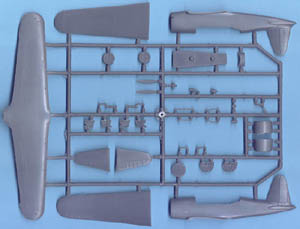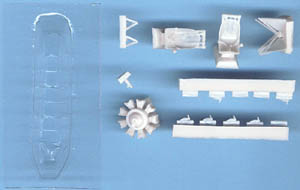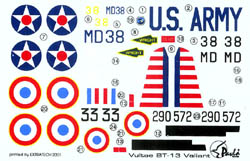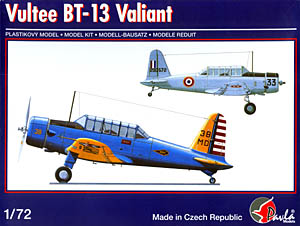Pavla's 1/72 Vultee
BT-13 Valiant | | History The BT-13 was one of three trainers built by Vultee in the hopes of securing a production contract. The first one, the BC-51, was the most complex and was in direct competition with the AT-6 for the Basic Combat or Advanced Trainer category. As the Oshkosh fly-in shows every year, we know who won that competition, with T-6s everywhere and the BC-51 being an only child. Next up was the Vultee Model 54, which was an Advanced Trainer outfitted with a 450hp Wright Whirlwind engine. This left the plane severely underpowered and inadequate as a trainer, and only after receiving BC-51 equipment and an R-1340 engine did it have any sort of decent performance. This plane remained at Vultee Field, mainly as a company hack aircraft, shuttling people around. The third trainer in the series proves the old phrase three time’s a charm, as the Model 54A, designed as a Basic Trainer, had the right performance and the right price at the right time. This airframe was selected by the USAAC in August of 1939 and became the BT-13. Named the Valiant, you’d be hard pressed to find any WW2 USAAC or Navy pilot who didn’t have time in the BT-13. By the time the production run ground to a halt, Vultee had produced 11,538 Valiants, twelve of those going to Peru.  After the war the BT-13 continued on, many ending up in private hands as crop dusters or even flying signs. The most famous BT-13s, though, would have to be the ones that starred in the movie Tora, Tora, Tora!. In this movie BT-13s were heavily converted to resemble Vals, which they did to great effect. After the war the BT-13 continued on, many ending up in private hands as crop dusters or even flying signs. The most famous BT-13s, though, would have to be the ones that starred in the movie Tora, Tora, Tora!. In this movie BT-13s were heavily converted to resemble Vals, which they did to great effect.
The Kit Boy, how long have we wanted a 1/72 (or 1/48 for that matter) injection-molded BT-13! Finally we have one, and while it will take a bit more work than a Hasegawa or Italeri kit, it looks like it will build up into a good representation of the BT-13. You get one sprue of medium gray injection-molded parts, a handful of tan resin details, a vacuform canopy, and a small decal sheet with choices for three aircraft. Like most Pavla kits, this one doesn't include every bit of detail, but the instructions do a good job of showing what needs to be added, should you choose to do so. The interior is the one spot that has the most room for improvement, although one part that won't need any help is the seats. These are very nicely cast resin pieces; complete with seatbelts and complete back frame structure. These fit onto a plastic floor, with the instrument panels and control sticks also in injection plastic. It's a pity Pavla didn't include a PE fret with the instrument panels, as that would have gone a long way to detailing the cockpit. The instructions have you make the rear deck, radio, support struts, and all four rudder pedal assemblies. The center four-post  structure is provided in resin. There is no sidewall detail provided, which under the greenhouse canopy will be very noticeable. Definitely a case of digging out the references and adding some bits and pieces. structure is provided in resin. There is no sidewall detail provided, which under the greenhouse canopy will be very noticeable. Definitely a case of digging out the references and adding some bits and pieces. The engine is provided in resin, with a two-piece cowling. On this goes a pair of scoops, provided in plastic. These will need to be drilled out. The wings are split into a one-piece lower section and right and left upper halves. The instructions show an eight-degree dihedral, but with the one-piece lower wing this shouldn't be a problem. The lower wing gets lots of treatment, with resin control arms for the flaps, two styles of landing gear, and instructions showing how to cut out the wing lights. There's also a resin venturi tube that goes on the centerline of the lower wing. The decals are printed by Extratech and are in excellent register. The three choices offer two US and one French example. The first US example is finished in the standard and rather colorful blue and yellow scheme seen on the boxtop. This plane  was flown at Wright Field, hence the Wright Field arrowhead emblem. The second example is a US Navy Valiant, finished in blue gray over light gray, flown from NAS Pensacola. The French example is an interesting one, used for training French pilots in the Christian Martell fighter school in Moroccan Meknes as late as 1952. The plane is overall natural metal, with aluminum dope on the control surfaces. was flown at Wright Field, hence the Wright Field arrowhead emblem. The second example is a US Navy Valiant, finished in blue gray over light gray, flown from NAS Pensacola. The French example is an interesting one, used for training French pilots in the Christian Martell fighter school in Moroccan Meknes as late as 1952. The plane is overall natural metal, with aluminum dope on the control surfaces. Conclusion While Pavla kits aren't exactly the easiest to build, they are generally fairly accurate and are often of subjects that aren't likely to be kitted by any of the major manufacturers. This is the case with the BT-13 and with a bit of work it will turn it into a nice model. References Easily the best reference for the BT-13 (and Vultee aircraft in general) is Vultee Aircraft 1932-1947, by Jonathan Thompson. In fact, the cover of this book has a color photo showing off some nice blue and yellow BT-13s. | 


 




|
